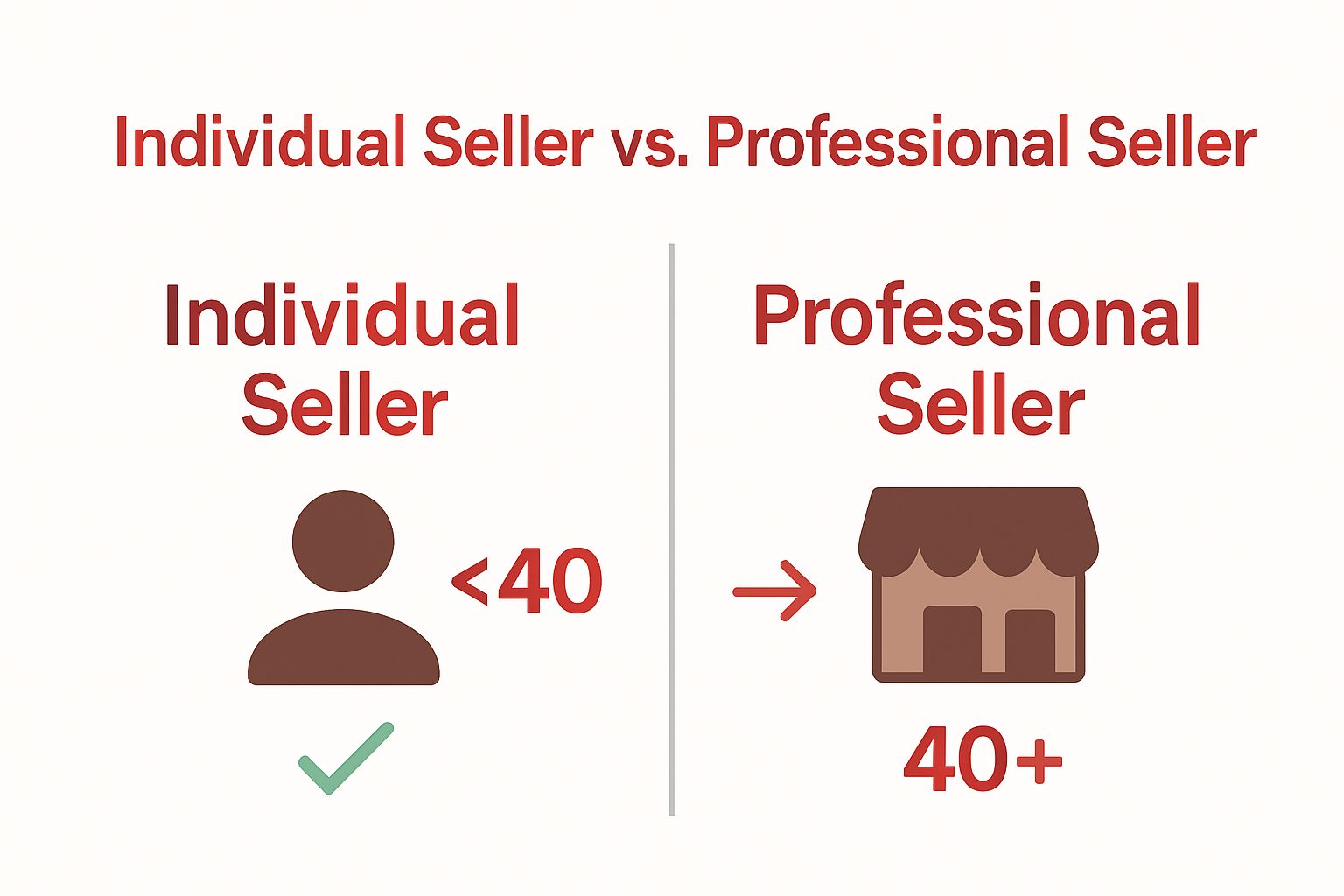
Understanding What is Amazon Marketplace: A Detailed Guide
Posted on
Amazon Marketplace is where anyone from solo entrepreneurs to global brands can put their products in front of shoppers all over the world. The wild part is that over 58 percent of all physical product sales on Amazon now come from third-party sellers. Everyone expects Amazon to dominate with its own listings but most sales actually come from regular people and businesses using the platform. That flips the typical retail story upside down and opens the door to all kinds of new players.
Table of Contents
- What Is Amazon Marketplace And How Does It Operate?
- The Importance Of Amazon Marketplace For Retailers
- Key Features And Benefits Of Selling On Amazon Marketplace
- Understanding Seller Types Within Amazon Marketplace
- Navigating Challenges And Opportunities In Amazon Marketplace
Quick Summary
| Takeaway | Explanation |
|---|---|
| Amazon Marketplace empowers diverse sellers | Sellers can compete globally with low upfront costs on a powerful platform. |
| Seller accounts cater to different needs | Choose between Individual, Professional, or Vendor accounts based on sales volume and business type. |
| Fulfillment by Amazon simplifies logistics | Using FBA can enhance shipping efficiency and customer satisfaction, crucial for sales. |
| Success relies on visibility and trust | High-quality listings and excellent customer service are essential for standing out in the competitive marketplace. |
| Market dynamics require constant adaptation | Understanding Amazon’s algorithms and pricing strategies can help sellers thrive amidst competition. |
What is Amazon Marketplace and How Does it Operate?
Amazon Marketplace represents a groundbreaking digital platform that fundamentally transforms how businesses and individual sellers connect with millions of potential customers worldwide. As an online selling environment, it offers entrepreneurs and brands an unprecedented opportunity to reach global markets without substantial upfront infrastructure investments.
Understanding the Marketplace Ecosystem
At its core, Amazon Marketplace functions as a robust eCommerce platform where third-party sellers can list and sell products alongside Amazon’s own inventory. Unlike traditional retail models, this digital marketplace allows sellers of all sizes to leverage Amazon’s massive customer base and sophisticated logistics infrastructure. Learn more about Amazon’s selling strategies with our comprehensive guide on marketplace management.
The platform operates on a unique model where sellers can choose between different selling approaches:
- Individual Seller Account: Perfect for sellers with fewer than 40 items per month
- Professional Seller Account: Designed for businesses with higher sales volumes
- Fulfillment by Amazon (FBA): Enables sellers to utilize Amazon’s warehousing and shipping services
Revenue and Competition Dynamics
According to Jungle Scout’s 2022 State of the Amazon Seller Report, third-party sellers now represent over 58% of physical product sales on Amazon. This statistic underscores the platform’s critical role in modern eCommerce. Sellers pay a referral fee typically ranging from 8% to 15% of the product’s sale price, which varies by product category.
The marketplace’s competitive environment demands strategic pricing, high-quality product listings, excellent customer service, and consistent performance metrics. Successful sellers understand that visibility and customer trust are paramount in this dynamic digital marketplace.
The Importance of Amazon Marketplace for Retailers
Amazon Marketplace has transformed from a simple online selling platform into a critical strategic channel for retailers across diverse industries. By providing unprecedented market access, advanced technological infrastructure, and global reach, the platform enables businesses to expand their commercial potential far beyond traditional boundaries.
Market Expansion and Customer Reach
For retailers, Amazon Marketplace represents a powerful gateway to millions of potential customers. Explore our comprehensive guide on maximizing Amazon selling strategies to understand the platform’s transformative potential. According to McKinsey’s Digital Commerce Research, online marketplaces now account for over 50% of global digital commerce transactions, highlighting their critical role in modern retail ecosystems.
The platform offers retailers several strategic advantages:
- Immediate Global Visibility: Access to Amazon’s 300 million active customer accounts
- Reduced Marketing Expenses: Leverage existing platform traffic and search algorithms
- Simplified Logistics: Utilize Fulfillment by Amazon (FBA) infrastructure
Economic and Operational Benefits
Retailers gain substantial operational efficiencies by integrating with Amazon Marketplace. The platform eliminates numerous traditional retail barriers such as:
- Expensive physical storefront investments
- Complex supply chain management
- High customer acquisition costs
- Limited geographic market penetration
By providing a standardized, technology-driven selling environment, Amazon enables retailers to focus on product quality, pricing strategy, and customer experience while minimizing operational complexities. The marketplace model essentially democratizes retail, allowing small and medium enterprises to compete alongside established brands with minimal initial investment.
This table summarizes the main operational and economic benefits retailers gain by selling on Amazon Marketplace, highlighting how the platform helps streamline processes and increase market reach.
| Benefit | Explanation |
|---|---|
| Immediate Global Visibility | Access to Amazon’s 300 million active customer accounts |
| Reduced Marketing Expenses | Leverage existing platform traffic and search algorithms |
| Simplified Logistics | Utilize Fulfillment by Amazon (FBA) infrastructure |
| Lower Initial Investment | No need for physical storefronts or major setup costs |
| Easier Supply Chain Management | Automate inventory and order processes |
| Decreased Customer Acquisition Cost | Sell directly to a vast buyer audience |
| Expanded Geographic Reach | Potential to sell in international Amazon marketplaces |
Key Features and Benefits of Selling on Amazon Marketplace
Amazon Marketplace offers a comprehensive suite of features designed to empower sellers with robust tools, advanced analytics, and unprecedented market opportunities. Understanding these features can transform how businesses approach online selling and scale their digital revenue streams.
Advanced Selling Tools and Infrastructure
Dive deeper into Seller Central strategies with our comprehensive guide that explores the platform’s intricate ecosystem. Sellers gain access to powerful technological infrastructure that streamlines complex eCommerce processes. According to Forrester Research, marketplace platforms like Amazon provide sellers with integrated tools that would typically cost thousands of dollars in independent development.
The platform’s key technological advantages include:
- Real-time Inventory Management: Automated tracking and synchronization
- Advanced Analytics Dashboard: Comprehensive performance metrics
- Dynamic Pricing Tools: Automated competitive pricing strategies
Financial and Marketing Advantages
Amazon Marketplace creates unique financial opportunities for sellers by reducing traditional market entry barriers. The platform enables businesses to minimize upfront investments while accessing a massive global customer base. Sellers can leverage multiple monetization strategies:
- Competitive commission structures
- Access to Amazon’s extensive customer network
- Multiple fulfillment options (self-fulfillment or Fulfillment by Amazon)
- International market expansion capabilities
The marketplace essentially democratizes online retail, allowing entrepreneurs and established brands to compete on a level playing field. By providing sophisticated technological infrastructure and global reach, Amazon transforms how businesses conceptualize and execute their digital sales strategies.

Understanding Seller Types within Amazon Marketplace
Amazon Marketplace offers multiple seller classifications, each designed to accommodate different business sizes, sales volumes, and operational capabilities. Understanding these seller types is crucial for entrepreneurs and businesses seeking to optimize their online selling strategies.
Individual and Professional Seller Categories
Explore our comprehensive guide on mastering seller strategies to understand the nuanced differences between seller types. According to Jungle Scout’s Seller Performance Report, seller account types significantly impact marketplace performance and growth potential.
The primary seller account types include:

- Individual Seller Account: Ideal for occasional sellers
- Professional Seller Account: Designed for established businesses
- Vendor Central Account: Invitation-only wholesale model
Specialized Seller Classifications
Beyond standard account types, Amazon provides specialized selling frameworks that cater to unique business models and market segments:
- Sellers utilizing Fulfillment by Amazon (FBA)
- Brand registry participants
- Third-party marketplace sellers
- Private label product developers
Each seller classification comes with distinct advantages, fee structures, and operational requirements. Successful sellers understand how to leverage these different account types to maximize their marketplace potential, optimize their sales strategies, and minimize operational complexities. The ability to choose and transition between seller types represents a significant strategic advantage in the dynamic Amazon ecosystem.
The table below compares the key characteristics, fees, and target audience of different seller account types available on Amazon Marketplace.
| Seller Account Type | Description | Key Features | Fees | Ideal For |
|---|---|---|---|---|
| Individual Seller Account | Suitable for small, occasional sellers | No monthly fee, limited selling tools | $0.99 per item sold, referral fees | Selling fewer than 40 items/month |
| Professional Seller Account | Designed for established, high-volume businesses | Access to advanced tools, bulk listings | $39.99/month plus referral fees | Businesses selling more than 40 items/month |
| Vendor Central Account | Invitation-only wholesale model | Directly supplies products to Amazon | Negotiated with Amazon | Brands/manufacturers selling large volumes |
| FBA Seller | Uses Fulfillment by Amazon services | Warehousing, shipping, customer service | FBA fees + referral fees | Sellers wanting hands-off logistics |
| Brand Registry Participant | Registered brand owners | Enhanced brand protection and marketing tools | Varies | Brands seeking to protect intellectual property |
Navigating Challenges and Opportunities in Amazon Marketplace
The Amazon Marketplace presents a complex ecosystem where remarkable opportunities coexist with significant operational challenges. Successful sellers must develop strategic approaches that balance risk management with aggressive growth tactics, understanding both the platform’s potential and potential pitfalls.
Competitive Landscape and Market Dynamics
Discover advanced strategies for marketplace success to navigate the intricate selling environment. According to Harvard Business Review’s Digital Commerce Analysis, successful marketplace sellers must continuously adapt to rapidly evolving algorithmic and competitive conditions.
Key competitive challenges include:
- Intense Price Competition: Constant pressure to maintain competitive pricing
- Algorithm Dependency: Performance heavily influenced by Amazon’s ranking systems
- High Customer Expectations: Demanding standards for shipping and product quality
Risk Management and Strategic Positioning
Sellers must develop comprehensive strategies to mitigate marketplace risks and capitalize on emerging opportunities:
- Diversifying product portfolios
- Implementing robust inventory management
- Maintaining exceptional customer service metrics
- Continuously monitoring performance analytics
The Amazon Marketplace rewards sellers who demonstrate adaptability, strategic thinking, and a commitment to understanding the platform’s complex ecosystem. By developing a nuanced approach that balances innovation with operational excellence, sellers can transform potential challenges into sustainable competitive advantages.
Take the Guesswork Out of Amazon Marketplace Growth
Struggling to unlock Amazon Marketplace’s full potential for your business? Many sellers face tough competition, unpredictable revenue, and complex operational challenges as described in our detailed guide. If you are looking for real solutions to product visibility, listing optimization, and multi-channel sales integration, you are not alone. The pressure to outperform, maximize profits, and reduce marketplace headaches is intense. That is where expertise becomes essential. For small and medium brands aiming for measurable results, navigating Seller Central and FBA on your own can feel overwhelming.

Discover how to turn challenges into opportunities by partnering with the experts at Reddog Group. Our team has managed over 50 brands and 30,000 SKUs with proven strategies tailored for sustainable growth. Ready to accelerate your Amazon sales? Visit our Digital & Business Consulting Services page to explore customized marketplace management. Do not let marketplace complexity hold you back. Start your path to real revenue growth now at https://reddog.group.
Frequently Asked Questions
What is Amazon Marketplace?
Amazon Marketplace is an online selling platform where third-party sellers can list and sell their products alongside Amazon’s own inventory, allowing businesses to reach millions of customers worldwide.
How do I choose between an Individual or Professional Seller Account on Amazon Marketplace?
If you plan to sell fewer than 40 items per month, an Individual Seller Account is suitable. For businesses with higher sales volumes, a Professional Seller Account is recommended, which offers additional features and benefits.
What are the benefits of using Fulfillment by Amazon (FBA)?
Using Fulfillment by Amazon (FBA) allows sellers to utilize Amazon’s warehousing and shipping services, which simplifies logistics, improves delivery times, and enhances customer satisfaction.
What are the main challenges sellers face on Amazon Marketplace?
Sellers face intense price competition, high customer expectations for product quality and shipping speed, and dependency on Amazon’s algorithms, which can impact visibility and sales performance.
Leave a comment: